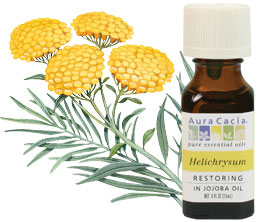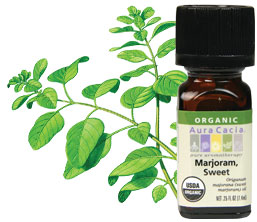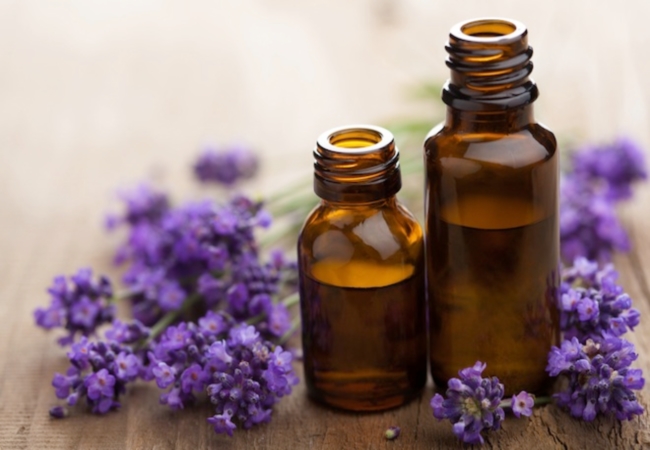Pain is one of the most common, as well as the most distressing medical symptom you can have, but remember, you’re not alone. Daily pain is experienced by tens of millions of Americans, and is one of the most common reasons for days off work. Furthermore, the American Chiropractic Association found that more than half of all workers suffer some form of back pain. Scientific studies have shown that essential oils can be an effective remedy for pain relief.
Essential Oils for Pain: Back Pain, Arthritis and Headache
They work because they directly target the brain’s emotional center, the amygdala. These pain-killing effects are uninhibited by the thinking brain, so you’ll feel the benefits straight away when using essential oils for pain.
Back Pain
To make your own back pain remedy, mix around 10 drops of your chosen essential oil with one ounce of carrier oil, then massage the oil into your sore muscles.
- Chamomile

Chamomile is popular as a flowering plant, and chamomile oil, with its characteristic dark blue color, can be extracted from its flowers. Chamomile oil is a famous anti-inflammatory agent, and can alleviate lower back pain, muscle pain/spasms, and premenstrual aches.
- Rosemary

Rosemary has an extensive range of health benefits, making it one of the most popular essential oils. The oil is usually extracted from rosemary leaves, and can be used in cooking. Rosemary has antispasmodic and analgesic effects, and it can alleviate joint, muscle, and back pain through boosting blood circulation.
- Clary Sage

Clary sage oil is among the popular essential oils for pain. To extract the essential oil, the leaves and buds of the clary sage plant undergo steam distillation. The clary sage herb has been used in medicine for centuries, particularly for promoting eye health and vision, and is thought to originate from Europe. It has anti-inflammatory and antispasmodic effects, and can be used to calm anxiety and relax tensed-up muscles. What’s more, clary sage oil helps with muscle stiffness, cramps, and back pain. However, you should not use this oil if you are pregnant.
- Ginger

Ginger essential oil is obtained from the odd-looking ginger root, a pungent rhizome. Ginger is warm, spicy, and stimulating, so is great for boosting circulation and libido. It is also one of the best essential oils for pain, relieving muscle aches, fractures, rheumatism, and back pain. Try adding a few drops of ginger oil to a hot or cold compress, which you can then apply to the affected region. Alternatively, add 2-3 drops to an ounce of carrier oil, for an effective massage oil. Finally, you can add it to a hot bath for soothing pain relief.
Arthritis
For an easy home arthritis remedy, try combining a few drops of essential oil with a small amount of carrier oil, then add the mixture to a hot bath.
- Wintergreen

Wintergreen, one of the lesser-known essential oils, is frequently used by Native Americans as a general painkiller, and is a powerful treatment for painful conditions such as menstrual cramping and arthritis. To extract the oil, wintergreen leaves are steam-distilled. Wintergreen oil is rich in a compound called methyl salicylate, which acts in a similar way to aspirin. Wintergreen essential oil can quickly kill pain and has a cortisone-type effect, with antispasmodic, analgesic, and anti-inflammatory properties. Bear in mind that wintergreen is one of the most potent essential oils. Therefore, it should not be used in children or anyone who has suffered epilepsy, and should never be ingested.
- Vetiver

When it comes to essential oils for pain, vetiver is relatively unknown in the Western world, but has been utilized in Ayurvedic medicine for centuries. It is a type of grass related to citronella and lemongrass, and vetiver essential oil is extracted from its roots. People use this oil for its grounding, balancing, and calming effects. It’s also known to have warming, antiseptic, antispasmodic, and immune-boosting properties. Moreover, vetiver has the ability to stimulate the circulatory system whilst relaxing the nervous system. It alleviates general aches and pains, particular those associated with arthritis, rheumatism, and muscular pain.
- Helichrysum

Helichrysum oil is known for its analgesic, antispasmodic, and anti-inflammatory effects. This oil is so effective that pain relief usually happens very soon after applying, and only small amounts are needed. Helichrysum is often used to support the nervous system and alleviate arthritic pain. Although the safety profile of helichrysum oil is very good, it may be worth checking with a healthcare professional before you use it. Furthermore, it has anticoagulant properties, so is not recommended for patients taking blood thinning drugs.
- Marjoram

Marjoram is often called the “happiness herb” and “joy of the mountains”. It’s extracted from fresh or dry marjoram plant leaves. Marjoram is a potent sedative, and is very effective in treating arthritic pain, muscle spasms, migraines, and stiff joints. Try mixing 2-3 drops marjoram essential oil in 1 ounce of carrier oil, then massage the oil into the affected areas of your body. You can also apply this mixture to hot or cold compresses.
Headache
- Lavender

Lavender is one of the most well-known essential oils for pain relief. What’s more, it’s also the kindest to your skin. People have long been using lavender to treat cramps, muscle strains, tension, headaches, and insomnia. Lavender oil has sedative and anti-inflammatory properties, due to its high concentrations of linalyl acetate esters. To relieve your headache, gently message a few drops of the oil onto your temples, forehead, and back of your neck. This is particularly effective at soothing evening and night-time headaches.
- Peppermint

Peppermint essential oil makes a fantastic remedy for headaches and migraines due to its high quantities of menthol, a natural compound that gives a relaxing cooling sensation and acts as a local anesthetic. To help soothe your headache, add three drops of peppermint oil to 1 tablespoon of water and mix well. Use a cotton ball to apply the mixture to your upper forehead just below the hairline, while keeping away from the eyes. After half an hour, the pain should decrease. For even greater effect, try adding a couple of drops of rosemary or lavender oil to the mixture.
